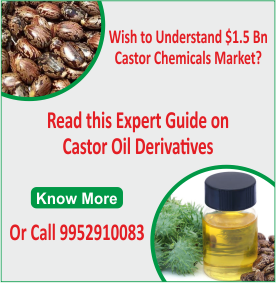Castor Oil & Castor Oil Derivatives
While castor oil by itself is used in diverse applications, chemical derivatives of castor oil find numerous uses in industrial applications and their domains of use are increasing rapidly.
This section of CastorOil.in provides info & resources for castor oil & castor oil derivatives/chemicals.
Castor Oil Characteristics & Facts
· Castor oil consists almost entirely of the triglycerides ricinoleic acid
· It ranges in colour from colourless to greenish
· It is a viscous & non-drying liquid
· It has a faint odour
· It has a slightly acrid taste, and a nauseating after-taste
· Castor oil does not become excessively viscous at low temperatures. It performs well as a high-temperature lubricant, well suited for use in jet, diesel, and race car engines.
|
Hydrogenated Castor Oil |
Hydrogenated castor oil (HCO) or castor wax is a hard, brittle wax that is insoluble. Hydrogenated castor oil or castor wax is produced by addition of hydrogen to castor oil (hydrogenation process) in the presence of a nickel catalyst. Read More:
|
|
Castor Seed Residue, also called Castor Meal |
Castor meal - the residue obtained from castor cake - is one of the most versatile natural manures. It serves as organic manure that enhances the fertility of the soil without causing any damage or decay. Read More:
|
|
12-Hydroxy Stearic Acid (12-HSA) |
12 HSA is an off-white solid fatty acid used to manufacture lithium and calcium based lubricating greases. When reacted with an ester, 12 HSA provides a hard finish for the automotive and small appliance industries. Read More:
|
|
Blown Castor Oil |
Blown or oxidized castor oil is prepared by blowing air or oxygen into it at temperatures of 80 – 1300C, with or without catalyst to obtain oils of varying viscosity. Read More:
|
|
Sulfated/Sulfonated Castor Oil |
Sulfated castor oil is also known as turkey-red oil. The traditional method of preparing turkey-red oil is to add concentrated sulfuric acid at a controlled rate to castor oil over a period of several hours. Read More:
|
|
Commercial Grade Castor Oil |
Industrial or commercial grade castor oil is obtained from a mixture of the first pressing and second phase of production - solvent extraction. Read More:
|
|
BP grade Castor Oil |
Bp Grade castor oil is generated from commercial grade castor oil by neutralization process and utilized in pharmacy and medical applications in Great Britain. Read More: |
|
Castor Oil European Pharmacopoeia |
European pharmacopeia grade castor oil is a highly refined product from commercial castor oil obtained by neutralization principles. Read More:
|
|
Castor Oil Pale Pressed Grade
|
Pale Pressed Castor Oil, a premium product in Castor Oil category is produced from the first pressing of the castor seed. Read More: |
|
First pressed degummed grade castor oil |
First pressed degummed grade castor oil is an early product of castor seed produced by degumming process , involving removal of plant polymeric substances so as to improve oil’ texture, colour etc. Read More:
|
|
First Special Grade (FSG) Castor Oil |
Castor oil FSG is produced by refining commercial grade castor oil using bleaching and filtering processes. Read More:
|
|
Castor Oil USP |
Pharmaceutical grade castor oil is produced from the first pressing of castor seed in which the oil does not lose any medicinal qualities.
|
|
Dehydrated Castor Oil (DCO) |
Dehydration of castor oil is carried out at about 250 degree Celsius in the presence of catalysts (e.g., concentrated sulphuric acid, activated earth) and under an inert atmosphere or vacuum. Read More:
|
|
Ethoxylated Castor Oil |
Ethoxylated castor oil is prepared by reacting 35 moles of ethylene oxide with 1 mole of castor oil which is capable of reacting as a non-ionic detergent in solutions. Read More:
|
|
Extra Pale Grade Castor Oil |
The extra pale grade of castor oil is obtained from the first pressing of the castor bean. Read More:
|
|
2-Octanol(Capryl alcohol) |
2-Octanol (Capryl alcohol) is a monohydric alcohol which is produced as a major product along with sebacic acid in the caustic fusion of castor oil under high temperature conditions. Read More:
|
|
Sebacic Acid |
Sebacic acid is a dicarboxylic acid. Sebacic Acid is a white flake or powdered crystal. It is resolved in ethanol, ether and soluble slightly in water. Two derivatives of sebacic acid are used in a range of applications as well. Read More:
|
|
Ricinoleic Acid |
Ricinoleic acid (12- hydroxy-9-cis-octadecenoic acid) is a light coloured, unsaturated omega-9 fatty acid that naturally occurs in mature castor plant (Ricinus communis L., Euphorbiaceae) which constitutes for about 90% of the castor oil. Read More:
|
|
Castor Oil C-18 derivatives |
Hydroxy Stearic Acid, Methyl 12-HSA, Methyl Ricinoleate, Zinc ricinoleate. Read More:
|
|
Castor Oil C-11 Derivatives |
Undecylenic acid, Undecanoic acid, Zinc undecylenate, Methyl undecylenate Read More:
|
|
Castor Oil C-7 Derivatives |
Heptanoic Acid, Heptaldehyde, Heptyl Alcohol (Heptanol) Read More: |
|
Castor Oil C-3 Derivatives |
Glycerine (Glycerol) is a key product of transesterification reaction in castor oil with properties of high viscosity and transparency. Read More:
|








